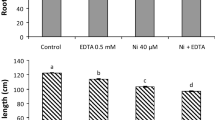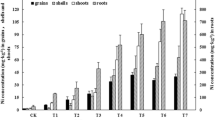Abstract
Difference in Ni tolerance/accumulation in plant genotypes might be used to identify or develop plants for remediation of high Ni soils. Ryegrass was shown to be more sensitive to Ni toxicity and accumulated much more Ni in shoots than maize. The objectives of this study were to examine the relationship of organic acids to Ni accumulation and xylem transport of Ni in ryegrass (Lolium perenne L.) and maize (Zea mays L.). The results showed that accumulation of Ni in shoots was 5 to 7 fold higher in ryegrass than in maize grown at 20 to 80 μM Ni, whereas Ni concentration in ryegrass roots was only 1 to 2 fold higher at 0.1 to 40 μM Ni and 1.5-fold lower at 80 μM Ni than that of maize roots. Xylem transport rates of Ni increased with increasing Ni supply for both species, and were about 2 to 7 times higher in ryegrass than in maize. Shoot concentrations of citric, malic, oxalic and cis-aconitic acids increased at Ni levels above 20 μM, and were about 2 to 6 times higher in ryegrass than in maize. Whereas, maize roots accumulated greater amount of malic, oxalic, and cis-aconitic acids than ryegrass roots, especially at Ni levels of 40–80 μM. The rate of Ni exudation by roots in the two species was significantly correlated with root Ni concentrations. It could be concluded that high Ni accumulation in shoots was closely related to high xylem transport rates of Ni and that the accumulation of organic acids, citric and malic acid in particular. A high root exudate rate of Ni and the enhanced accumulation of organic acids, malic acid in particular, in roots might be among the important factors which are associated with the tolerance of crops to toxic Ni levels.
Access this chapter
Tax calculation will be finalised at checkout
Purchases are for personal use only
Preview
Unable to display preview. Download preview PDF.
Similar content being viewed by others
References
Baker A J M, Brooks R R and Kersten W J 1985 Accumulation of nickel by Psychotria species from the pacific basin. Taxon 34, 89–95.
Brooks R R, Morrison R S, Reeves R D, Dudley T R and Akman Y 1979 Hyperaccumulation of nickel by Alussum linnaeae (Cruciferae). Proc. Royal Soc. Lond. B203, 387–403.
Brooks R R, Shaw S and Marfil A A 1981 The chemical form and physiological function of nickel in some Iberian Alyssum species. Physiol. Plant. 51, 67–170.
Brown P H, Welch R M and Cary E E 1987 Nickel: A micronutrient essential for higher plants. Plant Physiol. 85, 801–803.
Cakmak I and Marschner H 1988 Zinc-dependent changes in ESR signals, NADPH oxidase and plasma membrane permeability in cotton roots. Physiol. Plant. 73, 182–186.
Cataldo D A, McFadden K M, Garland T R and Wildung R E 1988 Organic constituents and complexation of nickel (II). iron (III), cadmium (II), and plutonium (IV) in soybean xylem exudates. Plant Physiol. 86, 734–739.
Eskew D L, Welch R M and Norvel W A 1984 Nickel in higher plants, Further evidence for an essential role. Plant Physiol. 76, 691–694.
Farago M E and Cole M C 1986 Nickel and plants. Metals Ions in Biol. System 20, 47–90.
Guo Y L, Schulz R and Marschner H 1995 Uptake, distribution and binding of cadmium and nickel in different plant species. J.Plant. Nutr. 18, 2691–2706.
Hammond P B and Foulkes E C 1986 Metal ion toxicity in man and animals. Metal Ions in Biol. System 200, 157–200.
Homer F A, Reeves R D, Brooks R R and Baker A J M 1991 Characterization of the nickel-rich extract from the nickel hyperaccumulator Dichapeialum gelonioides. Phytochem. 30, 2141–2145.
Lee J, Reeves K D, Brooks R R and Jaffre T 1977 Isolation and identification of a citrate- complex of nickel from nickel accumulating plants. Phytochem. 16, 1503–1508.
Nieboer E and Nriagu J O 1992 Nickel and human health: Current perspectives. John Wiley & Sons, New York.
Piccini D F and Malavolta E 1992 Effect of nickel on two common bean cultivars. J. Plant Nutr. 15, 2343–2356.
Reeves R D 1988 Nickel and zinc accumulation by species of Thalaspi L., Lochearia L. and other genera of the Brassicaceae. Taxon. 37, 309–318.
Symeonidis B L, McNeilly T and Bradsh A D 1985 Differential tolerance of three cultivars of Agrostis capillaries L. to cadmium, copper, lead, nickel and zinc. New Phytol. 101, 309–315.
Solomons N W 1984 The other trace minerals: manganese, molybdenum, vanadium, nickel, silicon, and arsenic. Curr. Top. Nutr. Diss. 12,269–295.
Welch R M 1981 The biological significance of nickel. J. Plant Nutr. 3, 345–356.
Yang X, Baligar V C, Martens D C and Clark R B 1996a Plant tolerance to nickel toxicity I. influx, transport, and accumulation of nickel in four species. J. Plant Nutr. 19, 73–85.
Yang X, Baligar V C, Martens D C and Clark R B 1996b Plant tolerance to nickel toxicity II. nickel effects on influx and transport of mineral nutrients in four species. J. Plant Nutr. 19, 265–279.
Author information
Authors and Affiliations
Editor information
Editors and Affiliations
Rights and permissions
Copyright information
© 1997 Kluwer Academic Publishers
About this chapter
Cite this chapter
Yang, X.E., Baligar, V.C., Foster, J.C., Martens, D.C. (1997). Accumulation and transport of nickel in relation to organic acids in ryegrass and maize grown with different nickel levels. In: Ando, T., Fujita, K., Mae, T., Matsumoto, H., Mori, S., Sekiya, J. (eds) Plant Nutrition for Sustainable Food Production and Environment. Developments in Plant and Soil Sciences, vol 78. Springer, Dordrecht. https://doi.org/10.1007/978-94-009-0047-9_116
Download citation
DOI: https://doi.org/10.1007/978-94-009-0047-9_116
Publisher Name: Springer, Dordrecht
Print ISBN: 978-94-010-6510-8
Online ISBN: 978-94-009-0047-9
eBook Packages: Springer Book Archive




